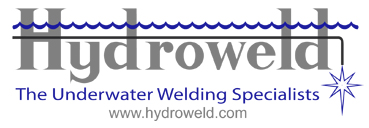|
The crocodile infested waters of the Mission River, at a distance of some 800-km from the
nearest town of 100,000, is the location for one of Australia's largest and prestigious
wet welding projects ever undertaken. The project on the Mission river bridge, is being
completed by Pacific Marine Group (PMG) based in Townsville, Queensland, Australia for
bauxite mining company - 'Comalco'.
The bridge, which is 1040m long, supports a single lane road and railway track used by
bauxite carrying trains which are up to 33 wagons in length with a gross weight of up to
5,000 tonnes. The bridge, constructed in 1971 to cross the Mission River comprises 55
spans 18m long and one 36m span. The piling is of a composite design with the upper part
(5-13m) being of pre-cast, pre-stressed concrete and the bottom sections being of hollow
octagonal steel section (HP2 pile section) or H-pile section. The concrete pile was cast
off-site with its lower end containing a short stub of the steel section protruding
approximately 450 mm. After transport to the site, a longer length of the steel section
(referred to as the pile tip) was butt welded onto this stub (this weld is referred to as
the "butt weld").
The original design intent was to have the steel pile tip driven into the riverbed and
only the concrete part exposed in the river. However, the channel in the Mission River is
sufficiently deep that this was not the case and, within 23 piers, there are 213 composite
piles with their steel pile tips exposed above the riverbed. The length of steel tip
exposed, above riverbed, varies up to 11 metres. All except one of the exposed steel tips
are of HP2 section. The HP2 section is an octagonal hollow section comprising 2 trough
shaped segments welded together and is the equivalent of a 400-mm tube with a wall
thickness of 16 mm. There are 17 piles in the bridge which are not of composite
construction but entirely comprise a steel HP2 section from toe to headstock. These were
generally installed prior to the main piling programme in order to prove founding
conditions.
During underwater inspection of the bridge supports piles, in 1996,
significant corrosion, including holes, was found on the exposed pile tips, with the worst
areas being at the butt weld in the HP2 section. Subsequent investigation showed that
Sulpha te Reducing Bacteria (SRB) predominantly caused the corrosion. Due to this corrosion
various operating restrictions were applied to the bridge and extensive analysis work
commenced to determine the repairs required. The objectives were to restore the bridge so
that there were no operating restriction above those that previously existed and to ensure
a 30-year life. te Reducing Bacteria (SRB) predominantly caused the corrosion. Due to this corrosion
various operating restrictions were applied to the bridge and extensive analysis work
commenced to determine the repairs required. The objectives were to restore the bridge so
that there were no operating restriction above those that previously existed and to ensure
a 30-year life.
Extensive diving work has been necessary over several years to inspect the piles, repair
defects and bond together the pile tips so that cathodic protection can protect the piles.
The piles also required sealing, in an attempt to prevent internal corrosion from
continuing. The work is made difficult by the nature of the site including; the existence
of salt water crocodiles up to 5 metres long, sharks, box jelly fish and stone fish in the
estuary. Tidal flows which, along with the monsoon, restrict the window for economic dive
campaigns and significantly reduce underwater visibility.
Welded repairs to the bridge were to be completed using the wet welding process. In order
to complete this work successfully, PMG, in 1997, approached Hydroweld, the
internationally recognised leaders in wet welding, to provide the wet welding technology
required by Comalco. In order to ensure the weldability of the piles welding procedures
had to be completed. A sample analysis of the bridge piles material showed that it had a
relatively high carbon equivalent of up to 0.45 CE which meant that the material is more
susceptible to hydrogen embrittlement and under-bead cracking when welded. Bearing this in
mind, Hydroweld set about developing formal wet welding procedures based on Comalco's
class 'A' structural weld quality requirements and in accordance the AWS D3.6
Specification for Underwater Welding. These procedures included the use of Hydroweld FS
wet welding electrodes, which have successfully been used to weld navel submarines with a
CE of 0.47, producing near surface quality welds.
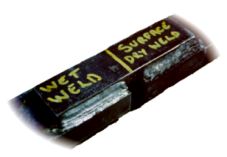 To ensure the welding procedures provided a true representation of the
production welds, it was agreed to complete them on site. On completion the west
welded coupons were sent to an independent test facility (Australia NDT) where the
destructive and non-destructive testing was completed. Australian NDT were amazed at
the quality of weld produce and 'couldn't believe that they were completed underwater'.
The results of the testing more than met the AWS D3.6 Specification and Comalco's
additional requirements whereupon the wet welding procedures were approved for production. To ensure the welding procedures provided a true representation of the
production welds, it was agreed to complete them on site. On completion the west
welded coupons were sent to an independent test facility (Australia NDT) where the
destructive and non-destructive testing was completed. Australian NDT were amazed at
the quality of weld produce and 'couldn't believe that they were completed underwater'.
The results of the testing more than met the AWS D3.6 Specification and Comalco's
additional requirements whereupon the wet welding procedures were approved for production.
To get the project started Hydroweld initially provided experienced wet welder divers from
the UK who, as with the welding procedures, completed the welder qualifications on site.
In addition to the UK welder divers, Hydroweld put together a job specific wet
welder-training programme, based on its internationally recognised wet welder training
courses run throughout the world on behalf of The Welding Institute (TWI). The course,
which was run at PMG's underwater welding facility in Townsville, provided wet welder
training for Australian divers, bringing them up to a standard required to complete the
welder qualifications and represented the first training course of its kind in Australia.
Hydroweld has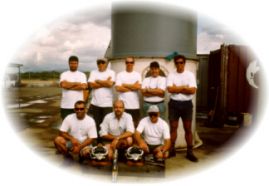 continued to provide PMG with an on going wet welder-training programme over
a 3-year period with a result that PMG can now provide an all Australian team to complete
the structural and non-structural welding. continued to provide PMG with an on going wet welder-training programme over
a 3-year period with a result that PMG can now provide an all Australian team to complete
the structural and non-structural welding.
The wet welding repair programme to the Mission Bridge proved to be an enormous task.
Since 1997 the wet welding time alone totals over 2000 hours, completing, for example,
some 206 structural plate repairs, 75 structural repairs to the butt welds, 522
non-structural repair welds and 220 welds to the CP bonds. All of the wet welding was
completed using Hydroweld FS wet welding electrodes with a total length of weld metal
deposited being in the region of 5.75 km. This has required some 38,500 electrodes
totalling 1.4 tonnes. Bob Brown, Wharf and Bridge Officer, for Comalco, said "we used
Hydroweld FS wet welding electrodes as they were proved to produce better mechanical
properties in the weld metal (important on a rail bridge with its higher potential for
fatigue)". Hydroweld also provided back up support and offered advice,
problem-solving solutions, personnel as required, set up the testing process and prove the
procedures on site. Hydrowelds' Phil Boulter (underwater welding specialist) put together
the welding procedures, training programme and provided onsite wet welding supervision.
Terry Dodd, Managing director of PMG, said "by including world leading underwater
welding consultants, Hydroweld, in the team Comalco got more than they ever thought they'd
get on the technical welding side of the project" he said "it has been very
successful".
PMG carry out regular inspection programmes on the bridge to ensure the welds continue to
meet the AWS D3.6 and Comalco's requirements. As structural welds they are continually
under load including cyclic loading but to date show no signs of fatigue or deterioration.
To provide protection against predators, divers have to work in the
confines of an extensive net enclosure supported by pontoons which were placed around the
pier being worked on, even so, occasionally crocodiles had to be coaxed out of the nets
having climbed in to them overnight. Terry Dodd, said, "The divers saw up to 3
crocodiles a day" sharks were also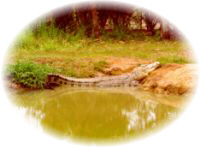 often seen in the evening as they came up the
estuary to feed. PMG's teams of up to 19 divers have completed over 3000 dives so far
equating to 5280 in-water man hours, with up to 4 divers in the water at a time on a pier.
In 1998 approximately 10% of the total in-water time was lost due to decompression so in
1999 Nitrox was introduced as the breathing medium for dives down to 56' (17 metres). An
equivalent air depth using a 60/40 Nitrox mix is 35' (<11 metres) thus the no stop time
is significantly extended from 60 minutes to 200 minutes using USN tables. The diving
operations ran smoothly with all parties working together with a common goal. often seen in the evening as they came up the
estuary to feed. PMG's teams of up to 19 divers have completed over 3000 dives so far
equating to 5280 in-water man hours, with up to 4 divers in the water at a time on a pier.
In 1998 approximately 10% of the total in-water time was lost due to decompression so in
1999 Nitrox was introduced as the breathing medium for dives down to 56' (17 metres). An
equivalent air depth using a 60/40 Nitrox mix is 35' (<11 metres) thus the no stop time
is significantly extended from 60 minutes to 200 minutes using USN tables. The diving
operations ran smoothly with all parties working together with a common goal.
The year 2000 should see the completion of the wet welded repair work to the satisfaction
of the client, and whilst further inspection programmes are being planed, the bridge
should get a stamp of approval and have the operating restrictions lifted. Comalco can
also be reassured that if, in the future, any further corrosion problems become apparent
they have at their disposal, a proven, reliable and high quality wet welded repair method.
|
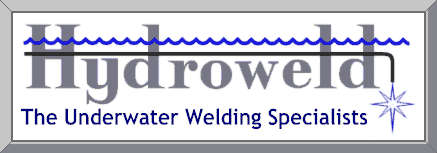
 te Reducing Bacteria (SRB) predominantly caused the corrosion. Due to this corrosion
various operating restrictions were applied to the bridge and extensive analysis work
commenced to determine the repairs required. The objectives were to restore the bridge so
that there were no operating restriction above those that previously existed and to ensure
a 30-year life.
te Reducing Bacteria (SRB) predominantly caused the corrosion. Due to this corrosion
various operating restrictions were applied to the bridge and extensive analysis work
commenced to determine the repairs required. The objectives were to restore the bridge so
that there were no operating restriction above those that previously existed and to ensure
a 30-year life. 